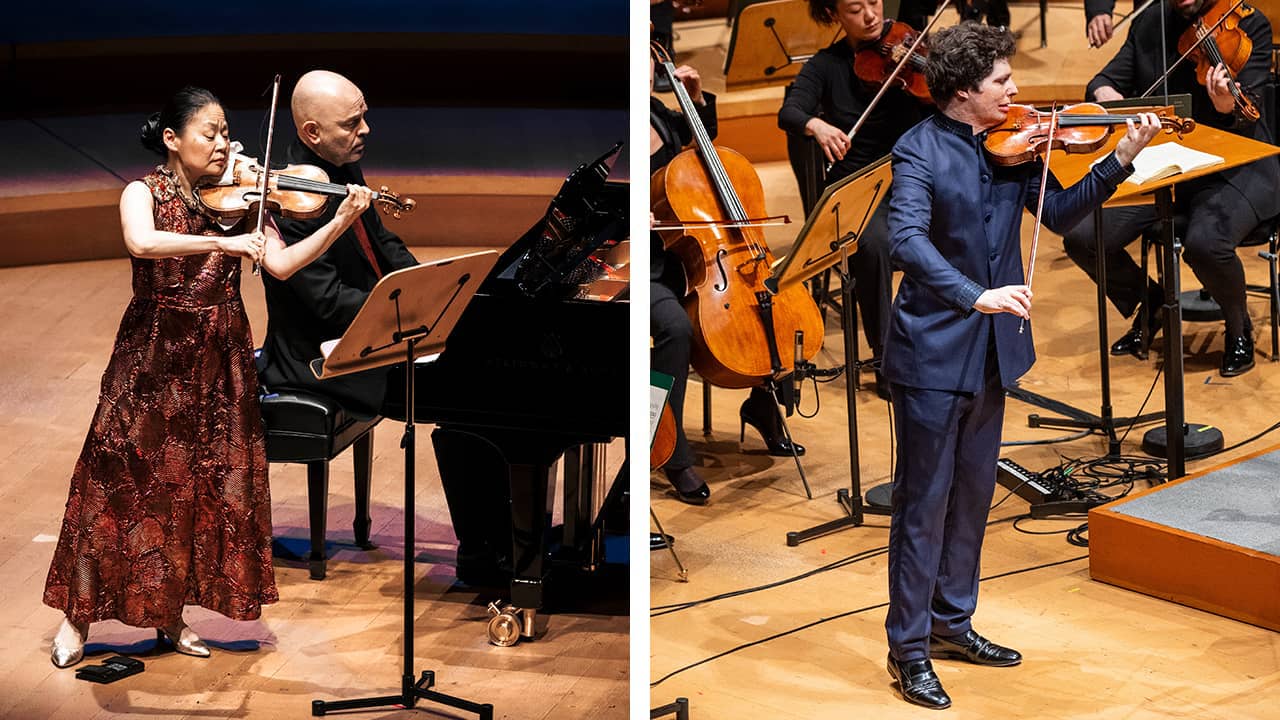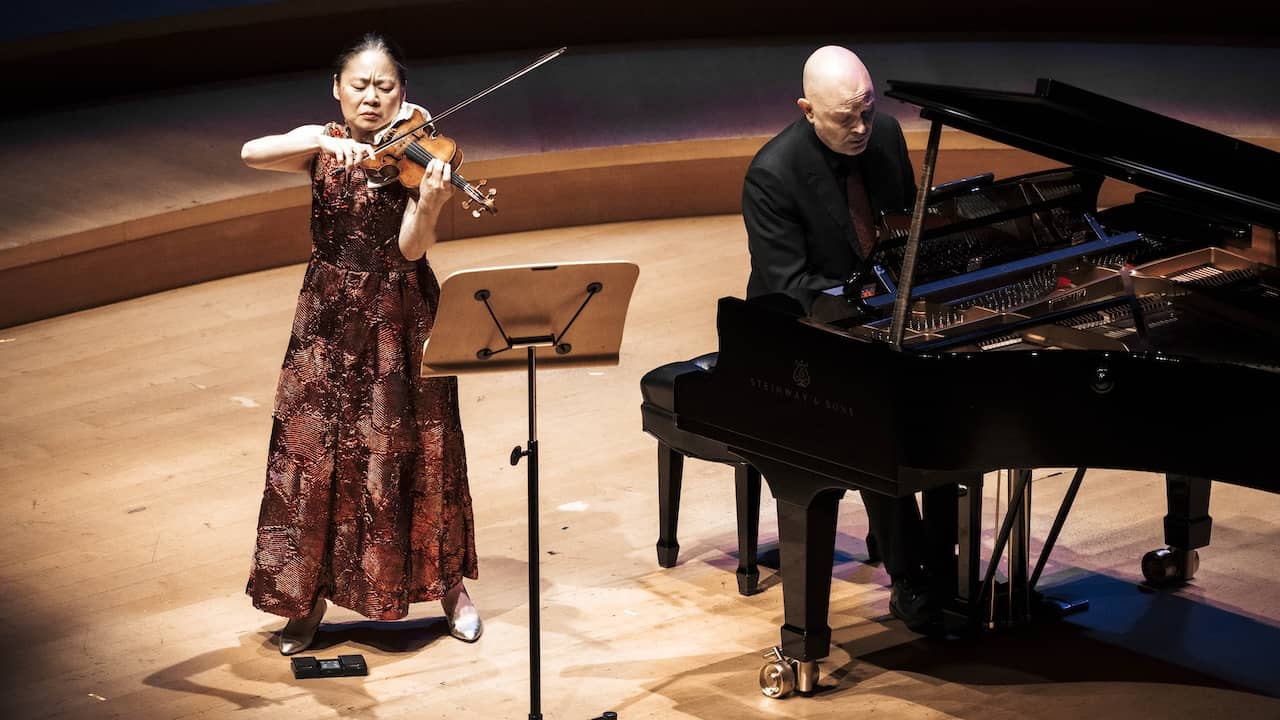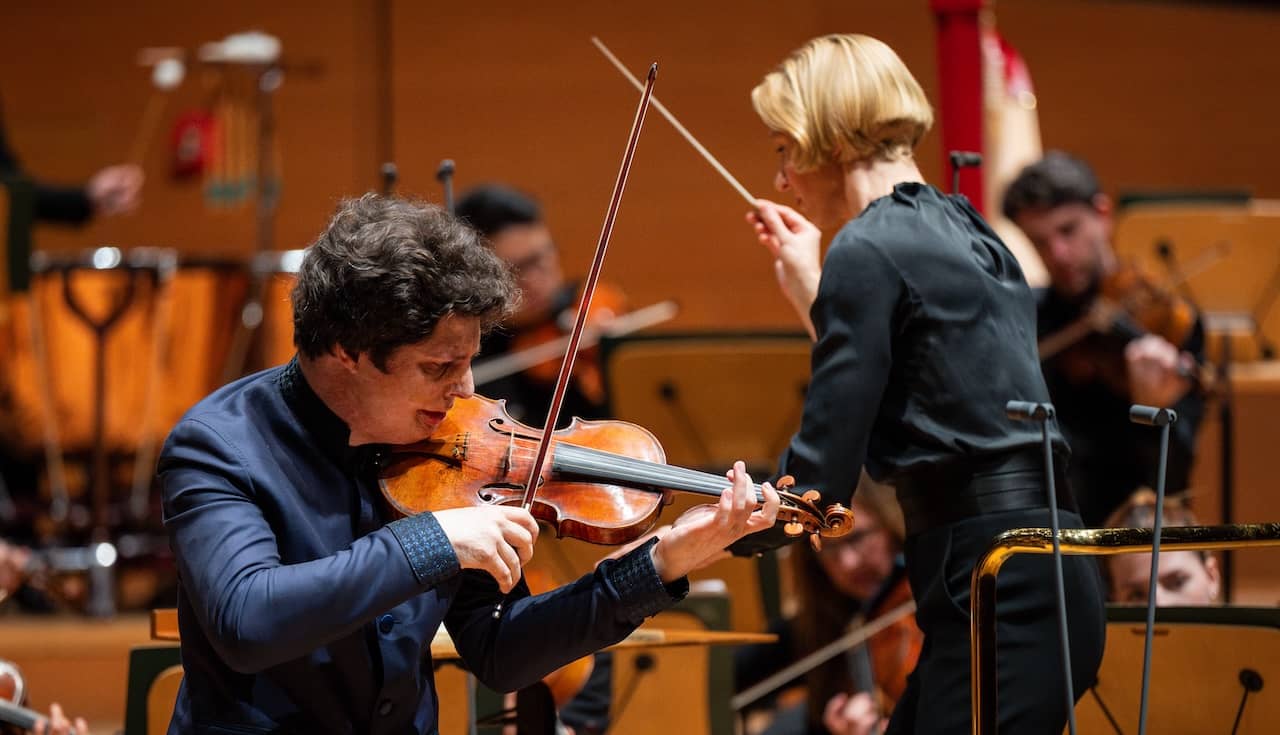Review: Midori, Augustin Hadelich - Two Great Violin Performances at Disney Hall
What a week in Los Angeles, if you are a fan of the violin! Two of today's finest violinists - Midori and Augustin Hadelich - appeared in separate concerts within 24 hours of each other at Walt Disney Concert Hall in downtown Los Angeles, both giving stellar performances.

Violinist Midori and pianist Özgür Aydin; and Augustin Hadelich with the LA Phil. Photos by Timothy Norris and Elizabeth Asher, courtesy of the LA Phil.
In a "Colburn Celebrity Recital" March 13 with her longtime musical partner pianist Özgür Aydin, Midori's performance culminated in a blistering, throw-down account of Ravel's "Tzigane." (In a moment of excitement I wrote "Slay, girl!" in my notes...) And Hadelich poured his elegance and mastery into the Tchaikovsky Violin Concerto during a morning concert March 14, keeping the Los Angeles Philharmonic and German conductor Joana Mallwitz on their toes with his original ideas and tempi. (Hadelich played two more performances with the LA Phil on Saturday and Sunday.)
Midori may have come to prominence last century as an international prodigy, but when she comes to Los Angeles today it feels like a homecoming - she is still welcomed as the exacting but nurturing violin professor who taught at the University of Southern California's Thornton School from 2004 (and as chair of the Strings Department from 2007) until leaving for The Curtis Institute in 2018 and beyond. Many of her former students were in the audience (though one told me that Midori was flying out right after the concert, so few of them actually got to visit with her!)
Thursday's recital was to have started with a commission by Che Buford, "Resonances of Spirit" for solo violin and electronics - but that had been replaced by Robert Schumann's "Five Pieces in Folk Style," Op. 102 - quiet, intimate salon music which, despite a beautiful reading, felt a bit introverted for a venue as large as Disney Hall.
Next was a piece from the same general era, Johannes Brahms' Sonata No. 1 in G major, and here the highlight was actually the second movement "Adagio," which began with gorgeous piano playing by Aydin, moving into the smooth and contemplative melody in the violin. What a beautiful moment after the double-stops, where time seemed to stand still.
In contrast to the fairly tranquil first half of the program, the second half was full of spicy attitude, forward motion and broken bow hairs, starting with Francis Poulenc's Sonata for Violin and Piano. Written in memory of the Spanish poet Federico Garcia Lorca who was assassinated for his political views, the beginning feels like a tempest from its time and place - World War II Europe. Midori immediately tapped into its intensity and frenzied motion, breaking a bow hair within the first two minutes. Mercurial, with myriad gestures, this music showcased the wonderful partnership between Midori and Aydin, who produced gorgeous colors in the second-movement "Intermezzo" and great drama in the last-movement "Presto tragico."
Next were two pieces by Maurice Ravel. In the "Kaddish" from "Deux Mélodies Hébraïques" Midori's violin became a voice, as she held every moment and sculpted the sound with a varied and perfectly-applied vibrato that sounded like grief, or a voice of the ages. She worked the audience into a silence and stillness that held for an unusually long time after they had finished playing.

Violinist Midori and pianist Özgür Aydin performing March 13 at Walt Disney Concert Hall. Photo by Timothy Norris, courtesy of the LA Phil.
And then the highlight - Ravel's "Tzigane." - a master class of impeccable timing and technique. The opening, which tests even the best G string's breaking point - showed no signs of breaking sound or wavering intonation. The octaves were so in-sync-in-tune, you almost couldn't tell they were octaves. Every gesture was sculpted to perfection, and the end was faster then I've ever heard it played - flying past the speed limit of sound, without missing a note. It was one of those performances I felt honored to have witnessed.
After many standing ovations, they played an encore: Hai Luli by the 19th-century composer Pauline Viardot.
* * *
Not 24 hours later, violinist Augustin Hadelich graced the same stage. This concert took place at 11 a.m., which seemed a good time, as the hall was completely full, and many concertgoers took the opportunity to simply stay after the concert and have lunch at Disney hall's cafeteria.
Hadelich last appeared with the LA Phil just eight months ago, when he played Prokofiev's Violin Concerto No. 2 at the Hollywood Bowl. Now he was back for the Tchaikovsky Violin Concerto, with conductor Joana Mallwitz, and Nathan Cole in the concertmaster seat.
Composed in 1878 and initially rejected by its dedicatee as "unplayable," the Tchaikovsky Violin Concerto is now one of the most frequently played and recorded violin pieces in existence, with more than a century of performance practice to inform - and haunt - the soloist.
Except Hadelich clearly is not haunted by anything - he joyously asserted his own interpretation, releasing entrenched practices without a hint of inhibition.

Violinist Augustin Hadelich performing with the LA Phil and conductor Joana Mallwitz March 14 at Walt Disney Concert Hall. Photo by Elizabeth Asher, courtesy of the LA Phil.
The opening of the concerto felt as welcoming as ever, with Hadelich's warm vibrato and beautifully calibrated dynamics. The tricky triplets were insanely fast, thrilling to see. Hadelich's elegance came forth when the theme is presented in a series of string-hopping double-stops. And Mallwitz pushed the orchestra to exciting speeds in the full-orchestra tutti leading up to Hadelich's solo cadenza.
During the first-movement cadenza, as the orchestra dropped out and Hadelich was on his own, I came to trust that whatever Hadelich was doing, it was just right. Using the bow (arco) where others pluck the string (pizzicato)? Fine with me. Use a nice bright open E there? Sure. An up-bow where everyone else does a down-bow? Do whatever you want, it works. In fact, it tickled me, I loved seeing how very well it works, to break with our inveterate violin habits.
The second movement was forward-moving: abundant flow - but a lot of ebb to go with it. The notes, pitch, tone were all perfection, but I wanted to linger over it a little longer!
The third movement was a swirl of notes - all individually crystal clear, with Hadelich hitting his mark rhythmically every time. A section of harmonics that usually has the soloist slowing down? No need, he blazed right through. He clearly was having fun, and the wild-fast ending was quite exciting.
Everyone roared to their feet in applause, and after several ovations Hadelich treated everyone to a wonderful encore: his own arrangement of "Por una cabeza" by Carlos Gardel (he generously offers the sheet music for free on his website; download the solo version here or the duet version
You might also like:
- Interview with Violinist Augustin Hadelich: a 20-year 'American Road Trip'
- Augustin Hadelich Offers His Arrangement of Orange Blossom Special for Free
- Video Interview with Violinist Augustin Hadelich, About 'del Gesù'
* * *
Enjoying Violinist.com? Click here to sign up for our free, bi-weekly email newsletter. And if you've already signed up, please invite your friends! Thank you.
Replies
It must have been a real pleasure to hear Midori's Poulenc. I have her recording with Robert MacDonald, and I haven't heard a recording that comes close.
This article has been archived and is no longer accepting comments.
Violinist.com is made possible by...
Dimitri Musafia, Master Maker of Violin and Viola Cases
International Violin Competition of Indianapolis
Violinist.com Holiday Gift Guide
Johnson String Instrument/Carriage House Violins
Subscribe
Laurie's Books
Discover the best of Violinist.com in these collections of editor Laurie Niles' exclusive interviews.

Violinist.com Interviews Volume 1, with introduction by Hilary Hahn

Violinist.com Interviews Volume 2, with introduction by Rachel Barton Pine









March 19, 2025 at 06:58 AM · Ah, Midori! Still one of the greatest violinists in history people somehow forget to mention.